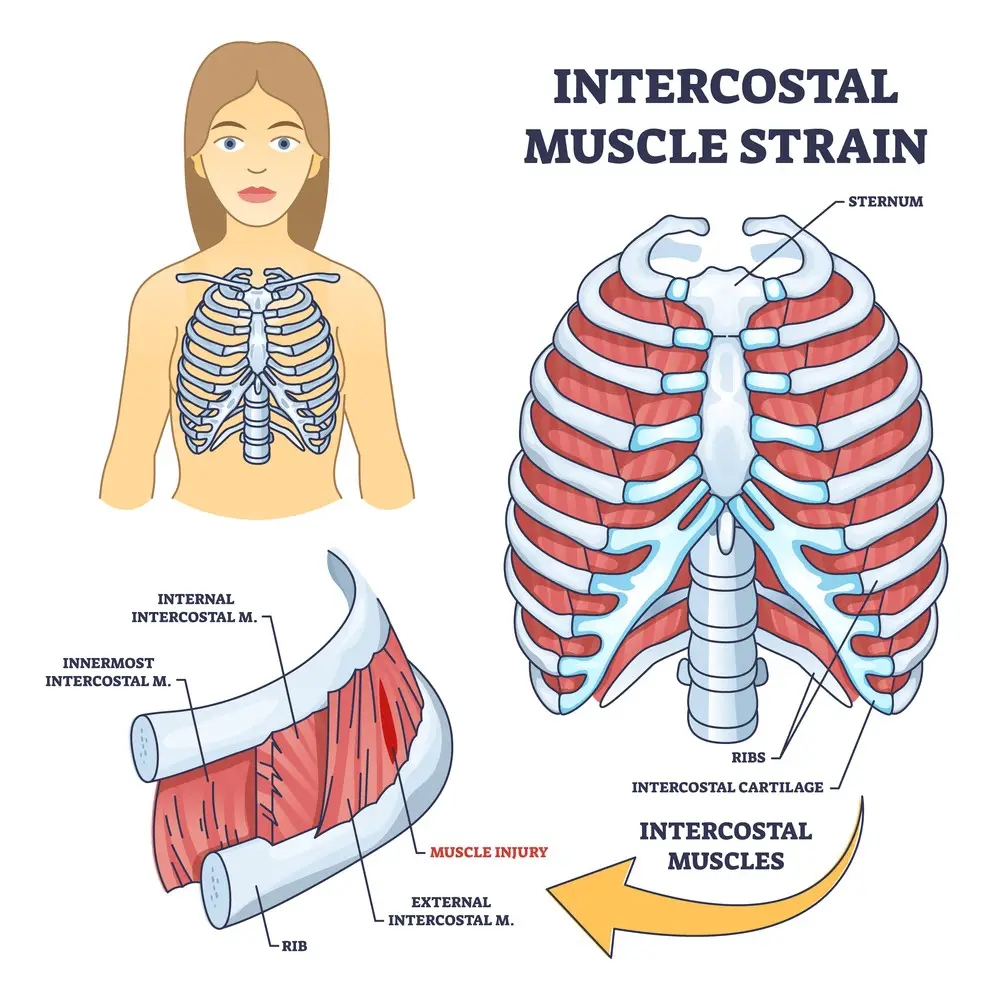As a BetterHelp affiliate, we receive compensation from BetterHelp if you purchase products or services through the links provided
Intercostal muscle strain can impact your quality of sleep. These muscles, located between the ribs, play a crucial role in respiration. Experiencing pain or discomfort due to a strain in these muscles can make finding a comfortable sleeping position challenging. This article will explore various strategies for sleeping with intercostal muscle strain, ensuring a more comfortable slumber.
Firstly, understanding the cause and treatment options for intercostal muscle strain is essential. This strain often results from heavy lifting, upper body rotation, or forceful coughing. Therefore, addressing the root cause of the strain should be a priority, which may include seeking medical attention and incorporating appropriate therapies such as gentle stretches, pain relievers, or ice and heat application.
Next, we will discuss specific sleeping techniques and positions to alleviate pressure on the strained intercostal muscles. This may involve propping oneself with pillows to reduce the strain on the chest and ribcage or experimenting with different sleep positions, such as lying on the unaffected side. Again, patience is essential as you discover which approach works best for your needs.
Understanding Intercostal Muscle Strain
Intercostal muscle strain is an injury affecting the muscles between the ribs. These muscles play a crucial role in maintaining the structural integrity of the ribcage and assisting in various respiratory processes.
Causes of Intercostal Muscle Strain
Intercostal muscle strain can have several causes:
- Physical activities: Intense workouts, contact sports, or any activities involving repetitive or forceful upper body movements put added stress on the intercostal muscles, increasing the risk of strain.
- Trauma or impact: Accidents, such as falls or vehicle collisions, can cause direct damage to the ribcage and intercostal muscles.
- Sudden movements or twists: Reaching, bending, or twisting in an awkward position may result in a strain due to the sudden stretch or contraction of the intercostal muscles.
- Prolonged coughing: Severe coughing can create repetitive stress, leading to intercostal muscle strain.
Symptoms of Intercostal Muscle Strain
People who experience an intercostal muscle strain typically report the following symptoms:
- Pain: Sharp, localized pain at the site of the strained muscle. The pain may worsen during activities that involve upper body movement or deep breathing.
- Swelling: In some cases, swelling or bruising may occur in the affected area.
- Restricted movement: Limited range of motion in the upper body, particularly when bending, twisting, or extending the arms and torso.
To recap, an intercostal muscle strain can result from various activities, traumatic events, or certain health conditions. Its symptoms include pain, swelling, and restricted movement in the upper body. Understanding these causes and symptoms is essential when alleviating discomfort and improving sleep quality.
Treatment for Intercostal Muscle Strain
Rest and Ice
The first step for treating intercostal muscle strain is to allow the body to rest and heal. Avoid activities that may worsen the pain or strain the muscles further. In the initial stages of the strain, applying ice to the affected area can help reduce inflammation and numb pain. Use an ice pack or bag of frozen peas wrapped in a towel, and apply it to the area for 15-20 minutes.
Heat Therapy
After the initial inflammation has subsided, heat therapy can be introduced to help with pain management and promote healing. Applying heat packs or warm towels to the strained muscles can increase blood flow, relax the muscles, and alleviate pain. Heat therapy should be used for 15-20 minutes several times daily, ensuring the heat source is not too hot to prevent burns.
Pain Medication
To further manage pain, over-the-counter pain relievers such as ibuprofen, naproxen, or acetaminophen can be used as part of the treatment plan. These medications not only help with pain management but also help reduce inflammation. Following the recommended dosage and consult with a healthcare professional if the pain persists or worsens is essential.
Additionally, in severe cases of intercostal muscle strain, corticosteroids may be prescribed to help decrease inflammation and manage pain more effectively.
Remember that a combination of rest, ice, heat, and pain medications works best to manage pain and promote healing in cases of intercostal muscle strain. However, each individual’s treatment plan may vary, so it’s crucial to consult a healthcare professional to ensure the best course of action.
Breathing and Mobility Exercises
Breathing Exercises
Breathing exercises can help alleviate pain and discomfort caused by intercostal muscle strains. One of the most effective breathing techniques is deep breathing. Deep breathing involves taking slow, deep breaths, which can help reduce pressure on the intercostal muscles and promote relaxation. To practice deep breathing:
- Sit or lie down in a comfortable position
- Place one hand on your chest and the other on your abdomen
- Inhale slowly through your nose, allowing your chest and abdomen to rise
- Exhale slowly through your mouth, letting your chest and abdomen fall
- Repeat this exercise for several minutes, focusing on the sensation of your breath
Another helpful breathing exercise is using a spirometer, which measures the volume of air you can inhale and exhale. It can help improve lung function and expand the chest muscles, promoting healing and comfort.
Stretching Exercises
Stretching exercises can help improve the range of motion and alleviate musculoskeletal chest pain caused by an intercostal strain. Some effective stretching exercises for the upper body include:
- Side bends: Stand with your feet shoulder-width apart and hands by your sides. Gently bend to one side, sliding your hand down your thigh. Hold the stretch for 15-30 seconds, then return to the starting position and repeat on the other side.
- Arm overhead stretch: Stand relaxed, placing one arm straight up overhead. Gently bend at the elbow and reach for the opposite shoulder blade, allowing the stretch to target the external intercostal muscles. Hold for 15-30 seconds and switch to the other side.
Mindfulness Meditation and Yoga
Incorporating mindfulness meditation and yoga into a routine can also be beneficial in managing pain and discomfort caused by intercostal strains. These practices focus on the connection between the mind and body and can promote relaxation, reduce stress, and improve overall health. In addition, some yoga poses, like gentle twists and cat-cow stretches, can gently stretch the internal and external intercostal muscles, promoting healing and flexibility.
Regularly practicing these breathing and mobility exercises can help improve the symptoms and discomfort associated with intercostal muscle strains. Incorporate these exercises into your daily routine for optimal results.
Sleeping Tips for Intercostal Muscle Strain
Choosing the Right Sleep Position
Finding a comfortable sleep position with intercostal muscle strain can help alleviate pain and promote better rest. Here are some suggestions:
- Side sleeping: Try lying on the unaffected side with a pillow between the knees. This position can alleviate pressure on the strained muscles and aid overall comfort.
- Elevated upper body: Use pillows or a wedge to elevate the upper body at a 45-degree angle. This position can reduce pressure on the intercostal muscles and make breathing easier.
- Fetal position: Gently pull the knees toward the chest while lying on the unaffected side. This position can open up the rib cage and alleviate muscle strain.
Ensuring a Proper Mattress
A suitable mattress can help support the body and alleviate pain caused by intercostal muscle strain. Here are some factors to consider when choosing a mattress:
| Mattress Type | Support | Firmness |
| Memory Foam | High | Medium |
| Innerspring | Medium | Medium-firm |
| Latex | High | Soft |
| Hybrid | Medium | Varies |
- Memory foam: Conforms to the body’s shape, providing support and pressure relief. Ideal for side sleepers and those with joint or muscle pain.
- Innerspring: Offers a bouncy, responsive feel. It has a good support system but may need to improve at pressure relief as memory foam or latex.
- Latex: Provides a balance of support and pressure relief. It is durable and naturally hypoallergenic, ideal for those with allergies or sensitivities.
- Hybrid: Combines the benefits of innerspring and foam materials, offering a balance of support and pressure relief. It appeals to a variety of sleepers due to its customizable features.
Remember, ensuring a proper sleep environment and finding the right sleep position can significantly improve comfort and assist in healing those with intercostal muscle strain.
Seeking Professional Help
Consulting a Healthcare Professional
Consulting with a healthcare professional is essential if one suspects they have an intercostal muscle strain. A proper diagnosis can help determine the severity and extent of the injury. In addition, a healthcare professional may perform various tests, such as X-rays or MRI scans, to determine the exact location and degree of strain.
Physical Therapy
Once the healthcare professional confirms the diagnosis, they might recommend physical therapy to help alleviate pain, promote healing, and strengthen the muscles. A physical therapist can provide specific exercises and stretches to target the affected intercostal muscles. These exercises can aid recovery by:
- Increasing flexibility and range of motion
- Building strength in the intercostal muscles
- Reducing pain and inflammation
Following the physical therapist’s instructions carefully and consistently is essential to achieve optimal results.
Additional Treatments
In addition to physical therapy, a healthcare professional may suggest other treatments to help manage intercostal muscle strain. These could include:
- Pain-relief medications: Over-the-counter pain relievers, such as ibuprofen or acetaminophen, can help reduce pain and inflammation.
- Heat and ice therapy: Applying heat and cold packs to the affected area may help alleviate pain and promote healing.
- Rest: Avoiding activities that exacerbate the strain is crucial during recovery.
Prevention of Intercostal Muscle Strain
Proper Physical Activity
Regular physical activity, mainly exercises focusing on strengthening the core muscles, can help prevent intercostal muscle strain. Activities such as yoga or pilates, emphasizing controlled movements and proper form, are particularly beneficial for avoiding strain.
Individuals who participate in sports should take care to:
- Warm up properly before engaging in any strenuous activity
- Incorporate regular stretching routines to maintain flexibility
- Aim for balanced muscle development to minimize the risk of strain
Incorporating these habits into daily routines can support overall fitness and prevent the occurrence of intercostal muscle strain during physical activities, whether during sports or everyday tasks.
Recognizing Warning Signs
Recognizing the early warning signs of a potential intercostal muscle strain is crucial to prevent further injury. These signs may include:
- A localized pain in the ribcage area, particularly during deep breaths or coughing
- A feeling of tightness or stiffness around the ribs
- Difficulty moving or twisting the torso
If any of these signs are experienced, it is essential to:
- Stop the activity immediately to avoid exacerbating the injury
- Allow the muscles to rest
- Apply ice to the affected area immediately to minimize inflammation
- Seek professional medical advice to assess the severity and determine the appropriate treatment
By adopting proper physical activity habits and recognizing the warning signs of strain, individuals can minimize the risk of developing intercostal muscle strains and maintain their overall health and well-being.
FAQs
- Stress Management: What is the Relationship Between Stress and Addiction? - June 28, 2024
- Exploring Techniques to Maintain a Healthy Lifestyle without Drugs - May 28, 2024
- How Acupuncture Helps Treat Chronic Fatigue Syndrome - May 28, 2024
This site contains affiliate links to products. We will receive a commission for purchases made through these links.




